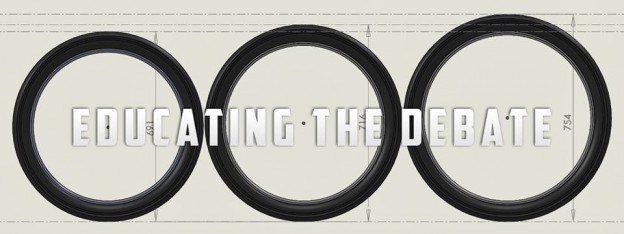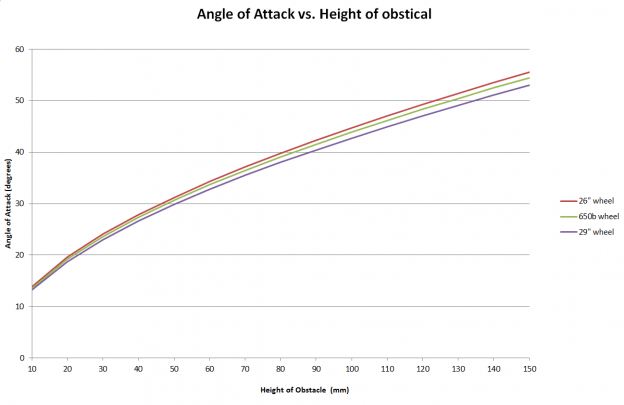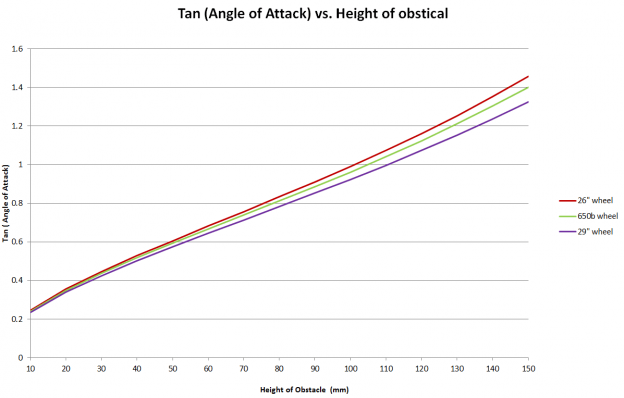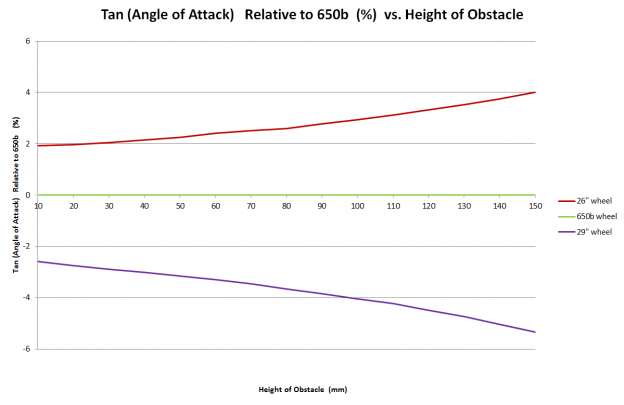
Educating the Debate – Part II
Time for some more sciencey goodness: Keith Scott of Banshee Bikes is back with another serving of reality for the wheel size debate. Head on back to Part I to catch up on where we’ve come so far, including a very civilized discussion in the comments.

Wheel Size Facts Part 2: Rollover Factors
In Part II of our unbiased discussion of wheel sizes, we’re going to continue with cold hard science. I will be taking the same dimensions discussed in Part I to perform these calculations, eliminating certain variables to ground the discussion. These theoretical calculations do NOT take into account tire deformation… which I will talk a bit about later. This week, get ready to deal with everyone’s favourite school subject – some trigonometry! So belt up, and let’s rollover some wheel-based maths (oh dear….!)
“Rollover”
You’ll almost definitely have heard 29er riders saying just how much better their bikes roll over obstacles on the trail. “I carried so much more speed through that rough section!”, or something similar. This is probably the key reason that riders and manufacturers give for having a bigger wheel size… But what does this mean, and just how much better do they perform this action?
The diagram below shows the height of a square-edge obstacle, and the angle of attack vis-à-vis the wheel:
When a wheel makes contact with a square-edge obstacle (for example, the curb of a pavement – that’s British speak for sidewalk), the angle of attack is the angle of the tangent of the wheel at point of contact with the square edge obstacle and the horizontal as shown above.

The angle of attack varies depending on wheel size and size of obstacle. Big wheels get the advantage here.
How each wheel size’s angle of attack varies with obstacle height across a range of square-edge obstacle heights. Of course these values are all perfect and theoretical (not taking into account tire deformation, tire pressure or bike lean angles etc.)
The angle of attack itself doesn’t really tell you much without applying basic trigonometrical functions to break it down into horizontal and vertical force vectors. In a simplified form without friction or deformation, if a wheel runs into a vertical obstacle higher than the axle height, it will stop you instantly (horizontal force / vertical force = infinity). Conversely, if an obstacle has zero height it will not slow you down at all (horizontal force / vertical force = 0).
In Fig. 3 below, you can see how the force vector varies as obstacle height increases for each wheel size; the higher the Tan (Angle of Attack), the more it will slow you down:
Fig. 4 shows how the force vectors vary as a % relative to the 650b wheel. A positive number represents a higher horizontal resistance (effectively, this means it slows you down more). So, you can see that 26″ wheels will slow down more than 650b wheels which in turn will slow down more than 29″.
This graph clearly shows that the relative efficiency is not consistent across all obstacle heights. The larger the obstacle, the larger the effect the wheel size will have. So it is impossible to say that one wheel is x% more efficient over square-edged hits than any other size without saying the size of obstacle, tire size, and tire pressure etc.
It should also be said that not only are big wheels more efficient at rolling over square-edge hits, but they also result in a smoother ride. This is because, for any given speed, the larger the diameter of the wheel the longer it is in contact with the obstacle (i.e. it hits it sooner and leaves it later). Therefore it has longer to react to the obstacle. Plus, the bigger the wheel the less of it is going to drop into holes (think braking bumps or between roots), hence 29ers feel like they smooth the trail out.
Once again I want to make it very clear that these numbers are based on wheels that do not deform at all, and that are rolling over perfectly square-edged obstacles, which is obviously not realistic. So let’s have a quick look at some real world factors that significantly complicate the situation.
Tire Deformation
Tire deformation helps to absorb the impact of hitting a square-edge obstacle. This not only reduces the shock that is transferred to the frame and rider, but also makes the wheel roll more efficiently over an obstacle by effectively reducing the angle of attack when it absorbs it. The more the tire absorbs the obstacle the better, so tires at lower pressure actually roll over obstacles like this more efficiently (unless you get a snake bite!).
Tire size is an important factor… for example you could realistically have a larger outside diameter running a very high volume tire on 26″ wheels than a small volume tire on a 650b wheel. In this situation the 26″ wheel would roll over things better than 650b, so overall tire height should be considered if analyzing options (see Part I if you need a refresher on this).
We have indeed confirmed that big wheels roll over obstacles better than small wheels, and help maintain momentum as a result. But frame geometry and axle path also play a factor if the frame has suspension, as the suspension can help absorption of obstacles and make the bike roll over them better. The slacker the head angle or more rearward the axle path, the better a bike will roll over an obstacle if all other factors are equal.
Plus there is one very very significant factor that none of these numbers take into account…We can bunny hop over things! This is why you should never listen to arguments taken from the automotive industry as the car can’t be thrown around independently of the driver.
If this second installment of wheel physics hasn’t boggled you even more than the first part, the third blog post will tackle contact area and grip. Woop!
Part I highlighted some advantages of smaller wheels, while Part II favoured the big wheels. Can we expect Part III to land right in the middle? Stay tuned…










Comments
JR
10 years, 5 months ago
"This wasn’t meant to start more arguments, it was meant to open eyes and help people appreciate just what each option offers. No one wheelsize is better than any other, it’s about which one is best for YOU!"
Exactly the point I was trying to make! But couldn't have said it better, Builttoride. Looking forward to the 3rd installment.
BTW. As far as I know…700c "road wheels" are effectively the same size as a 29″ wheel. 27″ road wheels went away quite awhile ago. Not sure the point Sketchl was trying to make.
Reply
Morgan Taylor
10 years, 5 months ago
Yes, the bead seat diameter of a 29″ rim is the same as a road rim, the true distinction being the width.
Reply
builttoride
10 years, 5 months ago
My real intention of this series is to try and help educate people with facts and relavent information, so that they aren't victims of marketing BS.
However what I'm hoping that people will realise by the end of the series is that wheel size is a personal thing (just like suspension setup) and so customers should be able to pick the wheel size option that works best for them based on their height, riding style, and terrain. This wasn't meant to start more arguments, it was meant to open eyes and help people appreciate just what each option offers. No one wheelsize is better than any other, it's about which one is best for YOU!
Reply
ErikMM
10 years, 5 months ago
Thanks for this, and part 1! I'll add it to my thoughts which centered around DH travel, and trail construction. In essence, unless my physics reasoning is wrong, all wheels will reach the bottom of a hill at the same time, or with a difference and average that I would not call "significant." See the math here: . I am still running experiments myself, but it's taking some time to do. I don't know that there is a bike company conspiracy and collusion, but I would put it past any multinational trying to make a dollar. The marketing BS is real, that I know…we have both shown that.
Reply
Sketchl
10 years, 5 months ago
Yeah peace man!
Note that I'd love to see the reaction of the respective bike fraternity if I turned up to roadie race/event with a 29′ or a bmx race with a 22′ bike!
Ciao Johnny, I never heard of a tall roadie complaining about 27′ wheels, buy a bike that fits you!
The industry tried 29′ and it hasn't worked so now they'll pursue 27.5′ just so they do look like fools.
Reply
Morgan Taylor
10 years, 5 months ago
I would disagree with your last point, as 29 has basically taken over in the short travel arena. The fastest riders will still be fast on smaller wheels, but World Cup XC racing – and trail riding in areas with a lack of technical terrain – is dominated by the big wheel.
Reply
JR
10 years, 5 months ago
What gets me about the whole wheel size debate is that in general people comment negatively on 29″ or 27.5″ wheeled bike without ever having thrown a leg over one! I'm 6'4″, and mostly legs, and my 29er is the first bike that has actually fit me properly and felt the way most 26″ bikes feel for shorter people. If the industry felt the same as Sketchl, then what…if you are taller than average you are S.O.L and have to suck it up and ride a bike thats too small and uncomfortable? Come on people…stop worrying about what everyone else is riding and just enjoy the ability to ride! Sure most of the wheel size issue is driven by marketing, but if it works for some then why the hate? I thought those types of comments were reserved for Pinkbike.
I ride a 29er, 26″ DH and DJ, roadbike…does that mean I'm not a mountain biker? Are only people that ride Harleys motorcyclist?
As Flatch said…we all ride bikes. I think the wheel size haters are the ones who are dividing the community.
Reply
flatch
10 years, 6 months ago
we all ride bikes man.
Reply
Sketchl
10 years, 6 months ago
Ciao Builttoride, unfortunately people won't read that far….it should be in the 1st paragraph!
Ciao Flatch, I do everything including climbing and 26′ works just fine. Note that my main point is that the whole wheel saga is dividing our MTB community even more than it already is, instead of uniting it!
Reply
Tonestar
10 years, 6 months ago
Sketchl,
If you are not actually interested in the information being supplied, or the topic at hand, then I suggest you don't bother commenting on said information or article.
I'm sure in Part 3 Builttoride will put all the information pertinent to your opinion in the first sentence, now that you have pointed out the error in his ways.
Thanks, and ride on man, ride on….
Reply
flatch
10 years, 6 months ago
PS never ridden a road bike and I don't wear lycra.
Reply
flatch
10 years, 6 months ago
hey sketchl, how much single track climbing do you do? I don't think bigger wheels means that you are a lazy rider,every wheel size has it's place.I for one applaud the industry for giving us real mountain bikers so much choice.no need to hate.
Reply
builttoride
10 years, 6 months ago
Sketchl: Your comment
'Note that if you were a proper mtb rider you’d be avoiding square edges and trying to pump anything that could gain you speed and avoiding everything that slows you down.'
Is exactly what I was refering to in the second last paragraph.
Reply
Sketchl
10 years, 6 months ago
Reacting typically as the whole wheel size saga is a joke!
Reply
Sketchl
10 years, 6 months ago
This is typical information that roadie type riders look for in assuring their big wheel purchase along with the market pushing new products. Note that if you were a proper mtb rider you'd be avoiding square edges and trying to pump anything that could gain you speed and avoiding everything that slows you down. Big wheels are for lazy riders looking for an easy way to mtb and Should buy a roadie and stay off the trails. People should stand back and look at what a joke the mtb scene has become!
Reply
Morgan Taylor
10 years, 6 months ago
Did you read Part I and Keith's premise, or are you just reacting "typically"?
Reply
whitehonky
10 years, 6 months ago
Did two laps in the park yesterday on the 29r, as I was coming off an all mountain ride and a ticket landed in my lap late in the day. I estimated the Commencal Meta29r with it's slack(er) angles and leggy travel would do well, as I've ridden that bike on more terrain this year than I would have imagined, but it truly was a revelation. CIU was so fast with unfortunately fun overshoots on pretty much all the hits and still able to tweak the bike out on many. The Ninja/Karate/Club combo was thrilling. Thought the berms would be too tight for the wheelbase, but it just trucked around them and Devils club felt freshly raked.
I wouldn't likely love it on In Deep or Goat Gully or Freight Train, but all the in between stuff might make a full day in the park worth exploring next year…. or maybe it was just riding such a light flickable bike in the park rather than the 26″ sled????
Or maybe it's just that all bikes are fun.
Reply
Rob Gretchen
10 years, 6 months ago
Awesome stuff… my college brain cells are being strained but keep it coming!!!
Reply
Please log in to leave a comment.